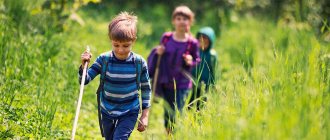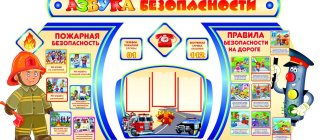Summer is the shortest and most awaited time of the year for children and their parents. While you have the opportunity, you want to do everything: take a walk, swim, ride a bike, and do other exciting things that you never have time for in winter. And so that the long holidays are not overshadowed by injuries and illnesses, it is enough to follow the summer safety rules for children: both adults and, of course, the children themselves.
Even if your child is a model of responsibility and caution, still remind him often of the basics of safe behavior in the summer. As the experience of traumatologists and pediatricians shows, even adults do not always know how to behave in an emergency situation, and children even more so.
Content:
- Children's safety in the summer - general rules
- Rules of behavior on ponds for children
- Safety in nature In the forest
- Games with fire
- Dangerous insects
- Thunderstorm and lightning - what to do
- Heat and sunstroke: signs, first aid
- Injuries, wounds, bruises
Camp setup
There are certain rules of behavior in nature for pitching tents and bivouacs. They need to be installed in a safe and open place, but not in clearings with moss. If you plan to plant them near water, it is better to do this outside the water protection zone. Dead wood is used for tent poles. Or you can take the stands with you, as well as pegs for fastening to the ground.
For toilets and food waste, you need to dig a hole, but no closer than 50 m from the reservoir. When leaving, you should bury it, or cover it with removed turf, and all debris should be burned. What will not burn, take it with you (products made of plastic, iron and glass).
Children's safety in the summer - general rules
Brief instructions on basic summer safety rules:
Bathing
You can only swim in places equipped for swimming; you cannot swim far or play unsafe games.
Sun
You should always wear a hat during the day - not only on sunny days, but also when there are clouds in the sky. Avoid being in direct sunlight for too long.
Food and water
It is necessary to carefully check the expiration date of products, do not take perishable food into nature, try to drink more clean, unsweetened water and always wash your hands before eating.
Insects
If there is a potentially dangerous insect (bee, wasp) nearby, you need to avoid sudden movements.
Communication
If a child is walking without his parents, he can only communicate with people he knows well. You can't call for help as a joke.
Are you worried about your child when he walks without your accompaniment? Rest assured that he is safe and in no danger. Download the “Where are my children” application from the AppStore and GooglePlay stores.
Rules of behavior on ponds for children
The safest way for children to have fun on the water is under adult supervision. But it’s not always possible to accompany your child everywhere, especially if he is no longer a baby, so be sure to tell your son or daughter about safe behavior on a pond or other body of water. And even if you go swimming together, children will still need these rules:
- if the child is under ten years old or does not have enough confidence in the water, use a swimming vest;
- Tell your children that playing “hide and seek” underwater or playfully trying to “drown” each other is very dangerous;
- explain why you can’t swim—let alone dive—in unfamiliar places or places heavily overgrown with algae: you can get hurt on rocks or debris, or find yourself at too great a depth, which can lead to tragedy;
- it is dangerous to swim long distances on inflatable mattresses - this is an unreliable means of swimming near the shore of a reservoir;
- control the duration of swimming - a long stay in cool water is dangerous due to hypothermia;
- Buy your child suitable shoes so that he does not get hurt on rocks on the beach or in the water.
Find a complete guide to safe behavior in water bodies in the material Safe Swimming: the most important rules for children and parents.
Rules of behavior in the forest
While in the forest, children must follow a number of simple rules of behavior:
- Stay constantly close to your loved ones, or within their visibility range.
- Do not pick or try unknown berries and mushrooms, they can be poisonous.
- Do not touch animals or insects. They can bite or carry serious infections. Do not pet or handle small cubs, as this can lead to serious consequences.
- Do not go close to lakes and reservoirs, and do not go into the water without adult permission. Water can hide many secrets, you need to remember this.
- At the first danger, immediately call an adult. There is no need to try to cope with the problem on your own; adult help will definitely come in handy.
Safety in nature
During the short summer period, city residents try to go out into nature as often as possible: into the forest, fishing, or to the country. And, of course, a family trip to nature is an excellent option for relaxing with children: the child will breathe fresh air away from the city and receive a supply of vitamin D necessary for the child’s body by taking moderate sunbathing.
When relaxing in nature with children, be careful: an active child may try unfamiliar mushrooms or berries, may want to play with fire, will not appreciate the risks of encountering insects, and will not know how to behave during a thunderstorm.
In the forest
Rules for safe human behavior in the forest:
- Clothing for adults and children must be appropriate: a tracksuit with long sleeves, non-slip shoes with thick soles, a hat. Please note: clothing should not fit tightly to the body - if a tick, mosquito or other dangerous insect tries to bite you or a child, it will be much more difficult to reach the skin through loose clothing than through tight-fitting ones;
- Do not try it yourself and do not let your child eat mushrooms or berries that are unknown to you. Explain to children that unfamiliar forest plants can cause serious poisoning;
- Make sure that children do not lag behind adults and do not go too far ahead. Tell them that you can easily get lost in the forest, but getting out is much more difficult. Talk to your child about what needs to be done if he still lags behind his parents: be sure to stay in place and call adults loudly.
Losing a child is a parent's greatest fear. To minimize risks and save your nerves, use a parental control app and a children's smart watch with a GPS tracker. This way you will have peace of mind for your child, no matter where he is.
Games with fire
According to Russian statistics, careless handling of fire by humans is the most common cause of forest fires. Follow fire safety rules in nature with your children:
- A child should not take matches or a lighter and try to make a fire on his own;
- You should not play with fire: throw objects into it that are not intended for lighting a fire (especially flammable ones), set fire to twigs or blades of grass from the flame;
- You can make a fire only in a properly equipped place: in an area cleared of grass, branches, and small debris. When leaving your vacation spot, make sure the fire is completely extinguished.
Dangerous insects
What to do if bitten by a dangerous insect - first aid:
Ticks
How to understand that a child has been bitten by a tick:
- a tick bite is often painless - therefore, when walking in the park or in the forest, examine the child often, especially the head under the hairline and the skin area behind the ears;
- if a tick crawls on clothing, just shake off the insect; ticks spend a long time looking for a place to bite;
- Female ticks are especially dangerous: they are the main carriers of infections. After a bite, they increase significantly in size and acquire a metallic tint.
First aid for a tick bite:
- remove the insect immediately after detection using tweezers or a special tick repellent (sold in pharmacies): grab the insect at the very base and pull it out with rotational movements;
- check whether the tick has come out completely; if the head remains in the skin, remove it with a sterile needle, treating the bite site with any alcohol-containing product before and after removing the insect head;
- Contact your pediatrician within 72 hours after the bite - the doctor will prevent borreliosis and prescribe the necessary tests.
For more information about what ticks look like, where they bite and how, in what weather they are active and how to protect yourself and your child, read the article Beware of ticks! What to do if a tick has already bitten?
Mosquitoes
How to avoid mosquito bites and what mosquito repellents a child can use:
- Use repellents that are appropriate for the child’s age and apply the product strictly in accordance with the instructions. It is best to carry repellent wipes with you;
- if it is not too hot outside, let the child dress in closed, light-colored clothes (mosquitoes are not attracted to light shades);
- if a mosquito has already bitten, and itching and irritation appear at the site of the bite, you can anoint the child’s skin with baby product after an insect bite or treat the affected area with calendula tincture;
- If other symptoms are added to skin irritation after a mosquito bite: severe itching, fever, consult a doctor.
Bees, wasps
To avoid wasp attacks, do not use cosmetics with a strong odor. A bee sting is more difficult to prevent - bees sting a person in order to drive him away from “their” place. In any case, as soon as a child is stung by a flying insect, immediately take your son or daughter away.
First aid for a bee or wasp sting:
- remove the tip without turning it - for example, with the blunt side of a knife;
- Observe the child’s condition: if he begins to choke and severe swelling appears, call an ambulance;
- If the child is not bothered by anything other than pain at the site of the bite, wash the damaged area of skin with soap and apply an age-appropriate remedy for flying insect bites, or apply a cold compress and leave for one hour.
Thunderstorm and lightning - what to do
Tell your child that a thunderstorm is not only fun and exciting, but also dangerous: lightning can cause a fire and seriously harm a person, leaving burns and other injuries.
How to understand that a thunderstorm is approaching, the exact signs:
- air humidity increases;
- it gets stuffy;
- Birds fly low.
What to do if you find yourself in a thunderstorm outdoors:
- if you are in an open area, leave it immediately;
- try to hide - not in a tent and in no case under a tree - if there are no strong buildings nearby, hide in a hole or other depression in the ground;
- move as far as possible from water - an excellent conductor of electricity;
- turn off mobile phones;
- get rid of metal objects, stay away from metal buildings and power lines.
How to protect your child from ticks
Remember that tick season begins in April-May. What a pity that even by uniting the efforts of all the parents of the world, we cannot once and for all defeat and abolish these unpleasant inhabitants of forests and parks.
You can protect yourself and your baby from contact with ticks by following these precautions:
- You need to dress properly and treat exposed areas of your body with repellent.
- It is advisable that the clothes be light-colored, with long sleeves, the cuffs are buttoned, and the trousers are long, with an elastic band at the bottom and, of course, a hat.
- When purchasing an insect repellent, make sure it says “tick repellent.”
- And of course, when you return home, do not forget to conduct a thorough inspection.
Food poisoning and dehydration
How to avoid food poisoning in your child in the summer:
- always wash your hands before eating, and if children are outdoors, wipe their hands with antibacterial wet wipes;
- do not take perishable food into nature;
- wash vegetables and fruits thoroughly;
- Do not give your child fruits that are already sold in stores, but the season for them has not yet come - such fruits may contain harmful substances that can cause poisoning.
If a child complains of abdominal pain and has nausea, vomiting, or frequent loose stools, let your son or daughter drink plenty of water and call a doctor.
Children suffer from dehydration more often than adults - especially in the summer, when it is hot outside and children play outdoor games.
How to prevent dehydration in a child:
- bring a bottle of water with you for a walk;
- If possible, remind the child not to forget to drink more, especially during outdoor play;
- teach children to quench their thirst only with clean water, and not with sweet soda or ice cream, which will make them want to drink even more;
- Spray water from a spray bottle onto your child’s skin before going outside.
Movement
It is imperative to look at your feet. And not only so as not to trample mushrooms and flowers, but also so as not to fall off the slope, not to step on a snake, etc. If there are paths in the area you need to walk through, then it is best to follow them. If a large group of vacationers has gathered in a clearing, it is better to disperse so as not to disturb the vegetation cover.
To avoid damaging lichen and moss, it is better to move on them when they are wet. You cannot go straight down the slopes. Ideally, you need to move at low speed and in zigzags.
Watch out, sun! Burns and overheating in the sun
Taking a walk in the sun is, of course, beneficial for a child, but in moderation, gradually getting used to solar activity. Excessively long exposure to the sun can lead to overheating, burns, heatstroke or sunstroke - and it is easier to prevent such troubles than to deal with long-term treatment later.
What your child needs to know about being in the sun in summer:
- maximum solar activity occurs from 10.00 to 16.00 - at this time it is better to spend less time outside so as not to overheat;
- if a tingling sensation appears on the skin, you need to immediately go into the shade;
- Sunscreen must be applied 15 minutes before going outside;
- When going outside, you need to wear a hat and loose, light clothing.
Heat and sunstroke: signs, first aid
Heat stroke, signs: lethargy, drowsiness, headache, nausea, dilated pupils, in severe cases - vomiting, loss of consciousness, convulsions, increased body temperature.
Sunstroke, signs: weakness, tinnitus, fever, nausea, vomiting, diarrhea, sometimes nosebleeds.
The main difference between heatstroke and sunstroke: heatstroke can be caused by extreme heat even indoors, while sunstroke can only be caused by being in direct sunlight for a long time. First aid for heatstroke and sunstroke is the same:
- move the child to the shade and call an ambulance;
- apply a cold compress to the victim’s head;
- free the child from clothing as much as possible, especially the upper body;
- let's drink not very cold water in small portions;
- wipe exposed areas of the child’s body with a damp cloth;
- If the child is nauseous, turn him on his side.
Burns
Symptoms of burns appear after several hours of exposure to the sun: the skin turns pink, itching appears at the burn site, touching the damaged areas of the body becomes painful. In severe cases, blisters form on the skin, the child’s temperature rises, nausea, and fainting are possible.
First aid for a child with sunburn:
- if burns are accompanied by fever or loss of consciousness, call an ambulance;
- if medical help is not required, take the victim to the shade and apply a cool compress to the burn areas;
- For treatment, use special anti-burn products that are sold in pharmacies.
Summer fun and child safety
Active recreation in summer is interesting and useful for a child: in winter it will no longer be possible to ride a bicycle, rollerblades or scooter. But any active sport can be dangerous! Bicycle accidents and falls are among the leading causes of childhood injury in the summer, according to statistics. Follow the safety rules during summer fun, and let your child’s health only improve from active activities!
Injuries, wounds, bruises
Tell your child what rules need to be followed during summer activities to minimize the risk of injury:
- when riding a bicycle, scooter, or rollerblading, it is necessary to protect vulnerable areas: wear a helmet, knee pads, elbow pads - pediatric surgeons claim that most injuries could be avoided if children were suitably equipped;
- roller skates, a bicycle or a scooter must be suitable for the child in size: the bicycle should not be low or too high, the rollers should fit the leg tightly, but not squeeze it;
- An electric scooter is a dangerous vehicle: it reaches high speeds, is poorly visible to motorists and interferes with pedestrians on the sidewalks, so it is better to choose a regular scooter over an electric scooter;
- Anyone can fall while skating - and you need to learn to fall correctly: group yourself, curl up in a ball, without putting your arms forward.
First aid for wounds:
- With clean hands, preferably wearing sterile gloves, remove dirt around the abrasion;
- treat damaged skin with brilliant green or iodine;
- if the bleeding cannot be stopped, call an ambulance.
First aid for bruises:
- apply cold to the injured area: ice, frozen foods, damp cloth;
- if the child complains of severe pain, you can give him a children's pain reliever;
- If the pain does not go away or even intensifies, consult a doctor.
It is difficult for an inexperienced person to assess the seriousness of the injury, and if a child falls from a great height, it is better to show the injury to a doctor, even if there are no complaints of severe pain, in order to exclude a possible fracture.
Active sports
If your child is interested in swimming, football, or rock climbing, follow the basic safety rules for active sports:
- Accustom your child to exercise gradually, especially if he does not have sufficient physical fitness;
- complex sports - rock climbing, diving and the like - are best trained in specially equipped places under the supervision of an instructor;
- Before each lesson, check whether the child is wearing protective equipment.
Playground safety
Inspect the playground yourself to make sure it is safe: whether there is glass or other debris on the territory, whether the swings are well secured. Teach children how to properly handle the swing: you can only approach it from the side; during other games on the playground, you need to move away from the swing.
Tell your children that in hot weather the metal gets very hot and it is better not to ride on the metal slide. Explain that tumbling on a trampoline when other children are there is dangerous; you can accidentally hit another child.
Memo to parents and children
Child safety reminder - the most important things:
- you cannot communicate with strangers - even if they are women or other children;
- if they try to take a child somewhere by force, you need to scream and try to attract the attention of adults by absolutely any means;
- if a child suspects that he is being persecuted, he must contact a policeman or go to a place where there are people (bank, cafe) and from there contact his parents;
- check if the child knows the phone number of at least one of the parents by heart - a son or daughter’s personal phone may get lost or run out of power, and it will be difficult to contact relatives without knowing the number by heart;
- if they try to attack a child in the entrance, let him loudly shout “Fire!”, knock on all the doors, break windows: in the event of an attack in the entrance, any means of attracting the attention of adults are acceptable;
- always know where your child is now and what he is doing using the application on your phone or GPS watch “Where are my children”: in real time you will know where your child is now, and where he has already been, and in case of danger Receive an alarm even if the call is not possible.
Despite the possible dangers, summer always remains the favorite time of year for both children and their parents. In the summer there are no educational worries, but there are many opportunities for bringing the family together: trips to nature, general sports activities, games and walks. Don't forget about reasonable safety rules - and don't let any troubles ruin your summer!
2




